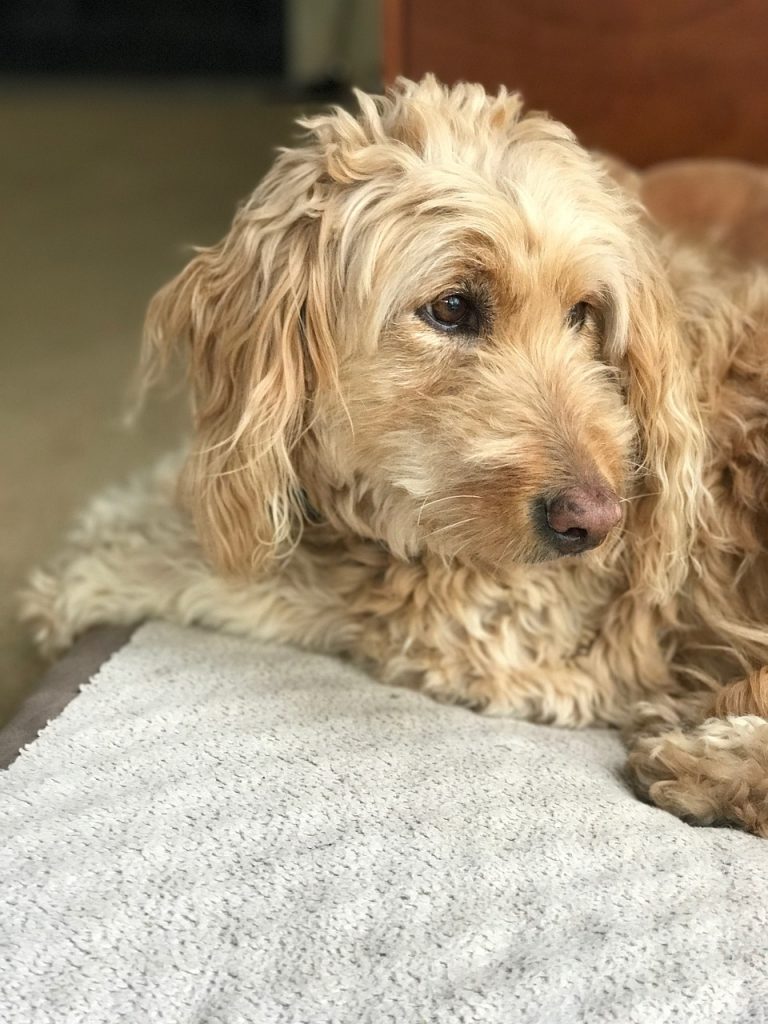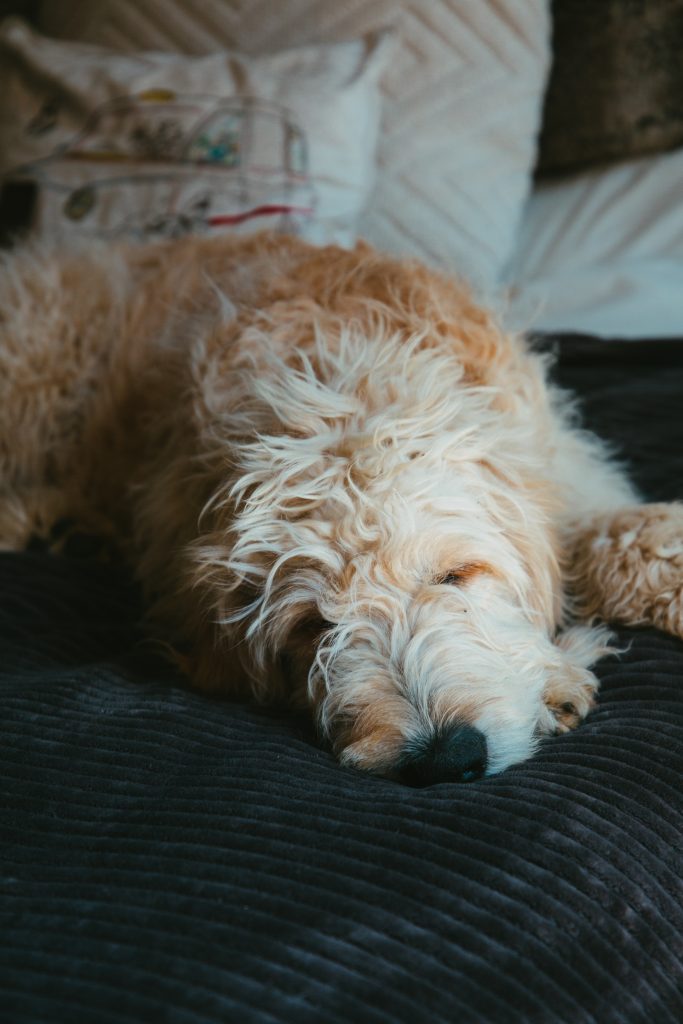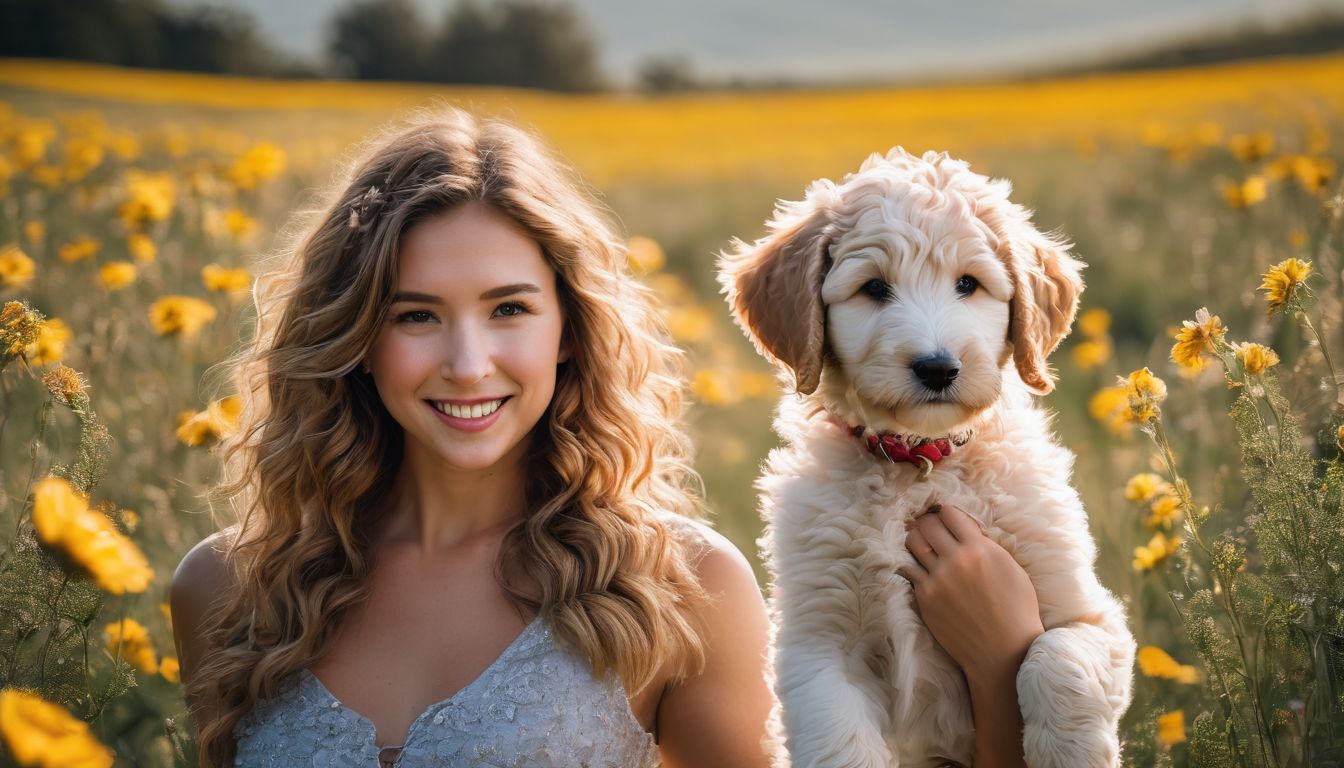How do you tell if a doodle will be curly? It’s interesting to note that their facial hair can offer clues about their future coat. This blog post will guide you on how genetics affects a doodle’s fur texture and the significant factors in determining whether they’ll be graced with curls.
Keep reading to master the art of ‘fur predictions’ for your delightful doodle!

Key Takeaways
- A Goldendoodle’s future coat type can be predicted based on genetics and observations of facial hair, but there can still be variations and surprises in individual dogs.
- The appearance of curly hair around a Goldendoodle puppy’s mouth is a good indicator that they will have tight curls as adults.
- Looking at the coats of the parents can give you an idea of what to expect in terms of the puppy’s future fur type. If both parents have curly coats, there is a higher chance the puppy will also have curls.
- Different coat types in Goldendoodles require specific grooming and maintenance techniques. Regular brushing is necessary for curly coats to prevent matting, while wavy or straight coats may need less frequent brushing.
Predicting a Goldendoodle’s Coat Type
Genetics play a significant role in determining a Goldendoodle’s coat type, but selective breeding also contributes to the desired curly or wavy hair.
Nature vs. Nurture: How genetics play a role
Dogs get their looks from genes. The curly hair of a Goldendoodle comes from the KRT71 gene. If a puppy has this gene, it will have curly fur. Not all puppies with this gene will have curls though.
Some may have wavy or straight fur instead. How many curl genes a pup gets helps decide its coat type too. This does not mean all pups from the same mom and dad will look alike though! Every pup can turn out different, even in one litter!
Breeding for desired coat types
Breeders play a big role in determining the coat type of Goldendoodles. They carefully select parent dogs with specific coat types to create puppies with desired traits. For example, if they want curly-haired Goldendoodles, they will choose parents that both have curly coats.
This increases the chances of their offspring having curly hair too. By intentionally breeding for certain coat types, breeders can help predict and produce Goldendoodles with the desired curly, wavy, or straight coats.
The KRT71 gene is also important in determining coat type as it influences whether a dog will have curls or not. With careful breeding strategies and consideration of genetics, breeders can increase the likelihood of producing Goldendoodles with particular coat types.

Factors that Influence a Goldendoodle’s Coat Type
Genetics, parental coats, the coat type of previous litters, and development stages all play a role in determining a Goldendoodle’s coat type.
Genetics
The type of coat a Goldendoodle puppy will have as an adult is determined by genetics. There is a specific gene called the KRT71 gene that plays a role in whether a Goldendoodle will have curly hair or not.
If the puppy has curly hair around its mouth, it is likely to have tight curls when it grows up. However, not every Goldendoodle will have curly hair. Some may have straight or wavy hair depending on the number of curl genes they inherit.
It’s important to keep in mind that these predictions are not always set in stone and there can be variations among individual dogs.
Parental coats
The coats of a Goldendoodle’s parents can give you clues about what their coat might be like. If both parents have curly coats, there’s a good chance the puppy will have a curly coat too.
However, if one parent has a curly coat and the other has a straight or wavy coat, the puppy’s coat could vary. It’s important to consider the genetics of both parents when trying to predict a Goldendoodle’s future fur type.
Remember, though, that there can still be surprises and variations in individual dogs.
Coat type of previous litters
The coat type of previous litters can give us some clues about what to expect in future Goldendoodle puppies. While it’s not a guarantee, looking at the coats of the parents’ previous litters can help predict the potential coat types of upcoming litters.
If most of the puppies from previous litters had curly or wavy coats, there is a higher chance that future puppies will have similar coat types. On the other hand, if previous litters had mostly straight-haired puppies, it is more likely that future litters will also have straight hair.
However, it’s important to remember that each litter can still have variations and surprises in individual dogs when it comes to their coat types.
Goldendoodles are known for having different coat types such as flat coats, wavy coats, and curly coats. The genetics play a big role in determining these different textures. So by looking at what kinds of coats were present in past generations, we can make an educated guess about what might be seen in upcoming pups.
While considering the coat type of previous litters can be helpful for predicting fur texture – please keep in mind that they aren’t 100% accurate indicators! Goldendoodles are mixed breed dogs with diverse genetic backgrounds which means there can always be some variation within each litter.
Development stages
Goldendoodle puppies go through different development stages as they grow into adults. One important stage is the coat transition period, which typically occurs between the ages of four and eight months.
During this time, the puppy’s soft and fluffy puppy coat starts to shed, making way for their adult coat to come in. This transition period is when you might start noticing changes in your Goldendoodle’s fur texture and appearance.
It is important to keep in mind that while there are certain predictions about a Goldendoodle’s future coat type based on factors like genetics and observations of facial hair, individual dogs may still have variations and surprises in their coats.

How to Determine if a Goldendoodle will be Curly
To determine if a Goldendoodle will be curly, observe the puppy’s snout, look at the parents’ coats, and consider the puppy’s coat texture. Curious to know more? Keep reading!
Observe the puppy’s snout
To determine if a Goldendoodle puppy will have curly hair, take a look at their snout. If the puppy has curly hair around its mouth, it’s likely that they will have tight curls as adults.
The appearance of curly fur in this area is a good indicator of their future coat type. Keep in mind that not all Goldendoodles will have curly coats, as some may have straight or wavy hair instead.
However, observing the snout can give you a hint about their potential curliness.
Look at the parents’ coats
To determine if a Goldendoodle puppy will have curly hair, it’s important to look at the coats of their parents. The coat type of the parents can give you an idea of what to expect in the puppy’s future fur.
If both parents have curly coats, there is a higher chance that the puppy will also have curls. On the other hand, if one or both parents have straight or wavy coats, then the puppy may inherit those coat types as well.
Keep in mind that genetics can be unpredictable, so there may still be variations and surprises in individual dogs. But looking at the parents’ coats can give you a good starting point in predicting your Goldendoodle’s coat type.
Consider the puppy’s coat texture
To determine if a Goldendoodle puppy will have a curly coat, you can consider their coat texture. Take note of how their fur feels when you touch it. If it’s soft and fluffy with a wiry or curly appearance, there’s a good chance they’ll have a curly adult coat.
On the other hand, if their fur feels straight or wavy, it’s more likely that they’ll have a straight or wavy adult coat. Keep in mind that puppy coats can change as they grow into adults, so these predictions are not always 100% accurate.
Caring for Different Coat Types of Goldendoodles
Different coat types in Goldendoodles require specific grooming and maintenance techniques. Regular brushing is necessary for curly coats to prevent matting, while wavy or straight coats may need less frequent brushing.
Understanding the unique needs of each coat type will help keep your Goldendoodle’s fur healthy and looking its best.
Types of Goldendoodle coats
Goldendoodles can have different types of coats, including flat coats, wavy coats, and curly coats. Flat coat Goldendoodles have hair that lies close to their body and requires less grooming compared to those with wavy or curly coats.
Wavy coat Goldendoodles have a loose wave in their fur, while curly coat Goldendoodles have tight curls all over their body. It’s important to note that the type of coat a Goldendoodle has can affect its grooming requirements and maintenance.
Grooming and maintenance tips
To keep your Goldendoodle’s coat looking its best, regular grooming and maintenance are important. The specific requirements will depend on the type of coat your Goldendoodle has. If your Goldendoodle has a curly or wavy coat, it is recommended to brush their fur daily to prevent matting and tangling.
For those with straight coats, brushing a few times a week should be sufficient. Bathing frequency can vary based on individual needs and lifestyle, but generally bathing every 4-8 weeks is recommended.
In addition to regular brushing and bathing, it’s also important to trim your Goldendoodle’s hair regularly. This includes trimming around their face, paws, ears, and tail to keep them clean and free from tangles.
Regular nail trims are also essential for maintaining good paw health.
Lastly, don’t forget about dental care! Dental hygiene is crucial for overall health. You can promote good oral hygiene by regularly brushing your Goldendoodle’s teeth using dog-friendly toothpaste.
Coat changes with age
As Goldendoodle puppies grow, their coats go through changes. The soft and fluffy fur they have as pups will transition into their adult coat between the ages of four and eight months.
During this time, you may notice some shedding as the puppy coat is replaced with a more mature coat. It’s important to note that not all Goldendoodles will have the same type of adult coat.
Some may end up with a flat coat, while others may develop wavy or curly coats. Each dog is unique, so there can still be surprises in how your Goldendoodle’s coat turns out even if you make predictions based on observations and genetics.

Conclusion
In conclusion, determining if a Goldendoodle will have curly fur can be done by observing the appearance of curly hair around their mouth. The KRT71 gene plays a role in their coat type, with curly coats being a result of this gene.
However, it’s important to remember that not all Goldendoodles will have curly fur and there may still be variations and surprises in individual dogs’ coats.
FAQs
1. What factors can help predict if a Goldendoodle’s fur will be curly?
Dog breeds, genes like KRT, and observing hair around the face and nose region can give tips for determining a Goldendoodle’s future fur type.
2. Can you observe facial hair to tell how curly a Goldendoodle’s coat will be?
Yes! The moustache appearance and beard can clue in on predicting Goldendoodle fur type and understanding their coat genetics.
3. What is the role of genetics in a Doodle breed’s fur texture?
Genetics play an important part in figuring out doodle coat characteristics. It impacts whether they have curls or end up shaggy like Teddy Bear Goldendoodles.
4. Are there ways to recognize different coat types in Doodle puppies?
Yes! Identifying curly coats in Goldendoodles involves watching for changes as the puppy grows, since Goldendoodlee coat transitions occur over time.
5. Is it easier to predict curliness in purebred dogs than mixed ones?
It’s not always easy to predict hair texture even with knowledge of genetics and fur because crossbred dogs like doodles may show variety.


